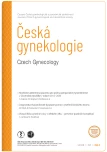Mateřské a fetální výsledky u následujících těhotenstvích pacientek, které podstoupily konzervativní operaci typu Acar pro spektrum placenty accreta
Authors:
N. Şengül 1; F. Yağbasan 2; A. Acar 3
Authors‘ workplace:
Dr. Ali Kemal Belviranlı Maternity and Children‘s Hospital, Konya, Turkey
1; Private Konya Farabi Hospital, Konya, Turkey
2; Department of Obstetrics and Gynecology, Necmettin Erbakan University Medical School of Meram, Konya, Turkey
3
Published in:
Ceska Gynekol 2023; 88(5): 328-333
Category:
Original Article
doi:
https://doi.org/10.48095/cccg2023328
Overview
Cíl: Tato studie si klade za cíl porovnat mateřské a fetální výsledky u následujících těhotenství pacientek, které podstoupily konzervativní (fertilitu šetřící) operaci placenta accreta spektra (PAS) a současných těhotenství pacientek po předchozím císařském řezu. Jeho cílem je zhodnotit proveditelnost konzervativní operace. Metody: Studie byla provedena v období od ledna 2011 do září 2021 na Porodnicko-gynekologické klinice Necmettin Erbakan University Meram Medical University Hospital. Soubory pacientek, které podstoupily segmentální resekci dělohy s diagnózou PAS a poté znovu otěhotněly a které podstoupily císařský řez, byly retrospektivně naskenovány z nemocničního systému elektronických záznamů pacientek bez diagnózy PAS, ale s alespoň jednou předchozí anamnézou. Císařský řez. Výsledky: Gestační týden, porodní hmotnost, intrauterinní růstová retardace a hodnoty APGAR byly porovnány s ohledem na výsledky plodu a mezi těmito dvěma skupinami nebyl nalezen žádný statisticky významný rozdíl. Sedm pacientek ve studijní skupině a jedna pacientka v kontrolní skupině vyžadovalo poporodní transfuzi (p = 0,026), infekce močových cest byly častější u pacientek s PAS v anamnéze (p = 0,038). Závěr: I když je císařský řez standardní léčebnou metodou v případech anomálie placentární invaze, konzervativní (uterus šetřící) operace se zdá být použitelná u pacientek s fertilitou i přes chirurgické komplikace. Konzervativní operace typu acar je důležitá jak z hlediska zachování fertility u PAS.
Klíčová slova:
spektrum placenta accreta – konzervativní operace – perinatální výsledek
Sources
1. Dogru S, Akkus F, Atci AA et al. The fetal and maternal outcomes related to previous number of cesarean sections and uterus sparing surgery in women with abnormal placentation. J Clin Invest Surg 2022; 7 (1): 25–30.
2. Dogru S, Atci AA, Akkus F et al. Use of ureteral catheter in uterine-sparing surgery for placenta accreta. Perinat J 2022; 30 (2): 158–164. doi: 10.2399/prn.22.0302009.
3. Wu S, Kocherginsky M, Hibbard JU. Abnormal placentation: twenty-year analysis. Am J Obstet Gynecol 2005; 192 (5): 1458–1461. doi: 10.1016/j.ajog.2004.12.074.
4. Harris RL, Cundiff GW, Theofrastous JP et al. The value of intraoperative cystoscopy in urogynecologic and reconstructive pelvic surgery. Am J Obstet Gynecol 1997; 177 (6): 1367–1371. doi: 10.1016/s0002-9378 (97) 70077-2.
5. Eller AG, Porter TF, Soisson P et al. Optimal management strategies for placenta accreta. BJOG 2009; 116 (5): 648–654. doi: 10.1111/j.1471-05 28.2008.02037.x.
6. Spiliopoulos M, Kareti A, Jain NJ et al. Risk of peripartum hysterectomy by mode of delivery and prior obstetric history: data from a population-based study. Arch Gynecol Obstet 2011; 283 (6): 1261–1268. doi: 10.1007/s0040 4-010-1554-6.
7. Tam Tam KB, Dozier J, Martin JN Jr. Approaches to reduce urinary tract injury during management of placenta accreta, increta, and percreta: a systematic review. J Matern Fetal Neonatal Med 2012; 25 (4): 329–334. doi: 10.3109/14767058.2011.576720.
8. Jauniaux E, Kingdom JC, Silver RM. A comparison of recent guidelines in the diagnosis and management of placenta accreta spectrum disorders. Best Pract Res Clin Obstet Gynaecol 2021; 72: 102–116. doi: 10.1016/j.bpobgyn.2020.06.007.
9. Acar A, Ercan F, Pekin A et al. Conservative management of placental invasion anomalies with an intracavitary suture technique. Int J Gynaecol Obstet 2018; 143 (2): 184–190. doi: 10.1002/ijgo.12593.
10. OECD. Caesarean sections. 2013 [online]. Available from: https: //data.oecd.org/healthcare/caesarean-sections.htm.
11. Jaraquemada JM, Pesaresi M, Nassif JC et al. Anterior placenta percreta: surgical approach, hemostasis and uterine repair. Acta Obstet Gynecol Scand 2004; 83 (8): 738–744. doi: 10.1111/j.0001-6349.2004.00517.x.
12. Karaman E, Kolusarı A, Çetin O et al. Local resection may be a strong alternative to cesarean hysterectomy in conservative surgical management of placenta percreta: experiences from a tertiary hospital. J Matern Fetal Neonatal Med 2017; 30 (8): 947–952. doi: 10.1080/14767058.2016.1192119.
13. Kilicci C, Sanverdi I, Ozkaya E et al. Segmental resection of anterior uterine wall in cases with placenta percreta: a modified technique for fertility preserving approach. J Matern Fetal Neonatal Med 2018; 31 (9): 1198–1203. doi: 10.1080/14767058.2017.1311862.
14. Provansal M, Courbiere B, Agostini A et al. Fertility and obstetric outcome after conservative management of placenta accreta. Int J Gynaecol Obstet 2010; 109 (2): 147–150. doi: 10.1016/j.ijgo.2009.12.011.
15. Sentilhes L, Kayem G, Ambroselli C et al. Fertility and pregnancy outcomes following conservative treatment for placenta accreta. Hum Reprod 2010; 25 (11): 2803–2810. doi: 10.1093/humrep/deq239.
16. Pineles BL, Coselli J, Ghorayeb T et al. Leaving the placenta in situ in placenta accreta spectrum disorders: a single center case series. Am J Perinatol 2022. doi: 10.1055/a-1885-1942. Online ahead of print.
17. Huang KL, Leung-Chit Tsang L, Cheng YF et al. Planned conservative management of placenta increta and percreta with prophylactic transcatheter arterial embolization and leaving placenta in situ for women who desire fertility preservation. Placenta 2020; 97: 51–57. doi: 10.1016/j.placenta.2020.06.003.
18. Mohr-Sasson A, Spira M, Rahav R et al. Ovarian reserve after uterine artery embolization in women with morbidly adherent placenta: a cohort study. PloS One 2018; 13 (11): e0208139. doi: 10.1371/journal.pone.0208 139.
Labels
Paediatric gynaecology Gynaecology and obstetrics Reproduction medicineArticle was published in
Czech Gynaecology

2023 Issue 5
Most read in this issue
- Včasná léčba synechie vulvy v dětském věku – prevence pozdních komplikací
- Relugolix kombinovaná terapie a symptomy děložní myomatózy – vybrané kazuistiky indikačního spektra a výsledků léčby
- Implementace ERAS protokolu v gynekologii a onkogynekologii – zhodnocení pilotní studie
- Rodící se myom jako příčina močové retence
